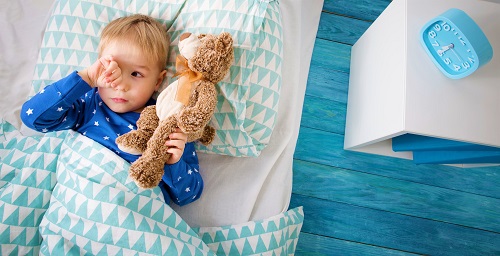Weighted blankets were first used by therapists to manage children with a variety of mood and behavior disorders. Today, they’re used in adults, especially to combat anxiety related insomnia. These weighted blankets offer a deep-pressure like sensation similar to a massage and lead to calming of the child. In fact, the weighted blankets paved way to a good night of sleep more often than not. Since then, a variety of different weighted blankets have been developed for toddlers. They are available in various sizes, styles, fabrics, weights, and colors.
Recommended reading: How to Choose the Right Weighted Blаnkеt Fоr Your Kid
How do weighted blankets work in toddlers?

image credit
https://www.lululook.com
The weighted blankets cause a deep pressure like sensation on the body, which stimulates the nerves that activate certain brain centers. In the brain, a number of neurotransmitters are released like melatonin and serotonin, which then produce a calming and sedative effect.
What types of weighted blankets should be used in toddlers?
In general, the weight of the blanket should not be more than 7-10% of the total body weight of the child. So if the toddler is 50 pounds, the maximum weight should not be more than 5 pounds. If the child has autism or is having difficulty sleeping, then a heavier weighted blanket should be selected as it provides a more soothing effect. The smallest weighted blankets for toddlers weigh about 5 pounds.
What else can I do to make the toddler sleep better?
It is important to understand that weighted blankets, though safe, cannot cure insomnia or any type of mental health disorder. However, they can improve sleep, and provide a calming sensation. To get the maximal benefits from weighted blankets in toddlers, the following are recommended:
- Cut out all caffeinated or cola beverages, especially a few hours before bedtime
- Make sleeping a routine; this means getting the toddler to bed at the same time every day
- Minimize the amount of screen time just before bedtime
- Avoid feeding the toddler with a heavy meal just before bedtime. Provide supper a few hours early and only limit the toddler to snacks if he or she is hungry afterwards
- Avoid intense physical activity or over-stimulation of the toddler before bedtime
- Make sure the bedroom is free of distractions like the TV
- Ensure that the bed is comfortable
Which toddlers should not have a weighted blanket?
Safety should always be a priority. Weighted blankets should not be used in children less than 24 months old or less than 2 years old. Infants are at great risk of sudden death infant syndrome. The most critical fact is to select the safe size and weight of the weighted blanket. If you are unsure about the weighted blanket, speak to an occupational therapist; these professionals can guide you to the appropriate size and weight of the weighted blanket for your child. Finally, when you have selected the blanket, always observe the toddler a few times while sleeping. The weighted blanket should not become tangled or produce distress in the child.
Can a weighted blanket help my toddler?

image credit
https://busycreatingmemories.com
The thing to understand is that weighted blankets are safe but are not a panacea for all health problems in toddlers. They were originally meant for autistic children, and still are, to a certain extent. However, weighted blankets can produce good sleep but have to be used regularly for their benefits. For toddlers, you should select a weighted blanket that has a soft fabric like cotton or fleece and feels comfortable on the skin. If your toddler has allergies, then avoid weighted blankets with feathers.

